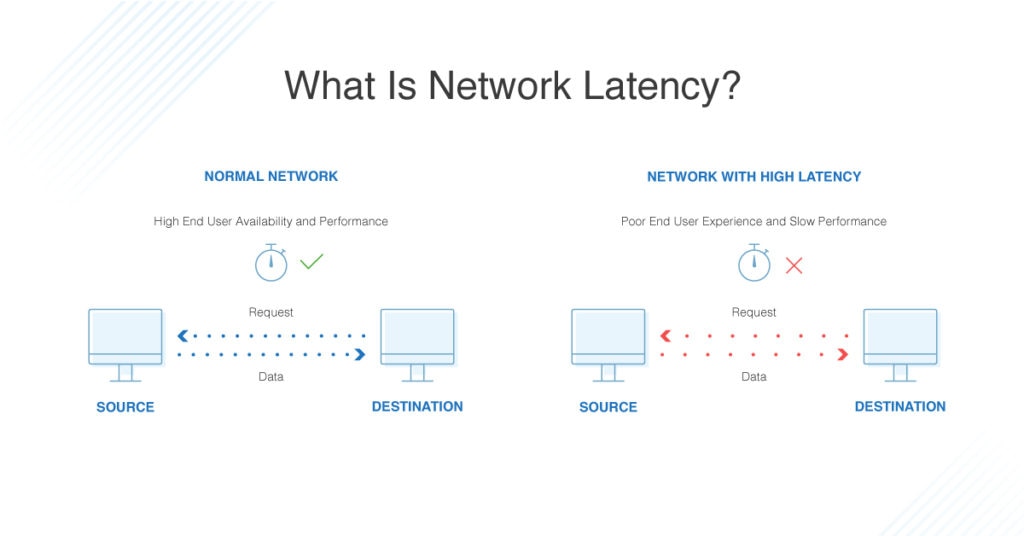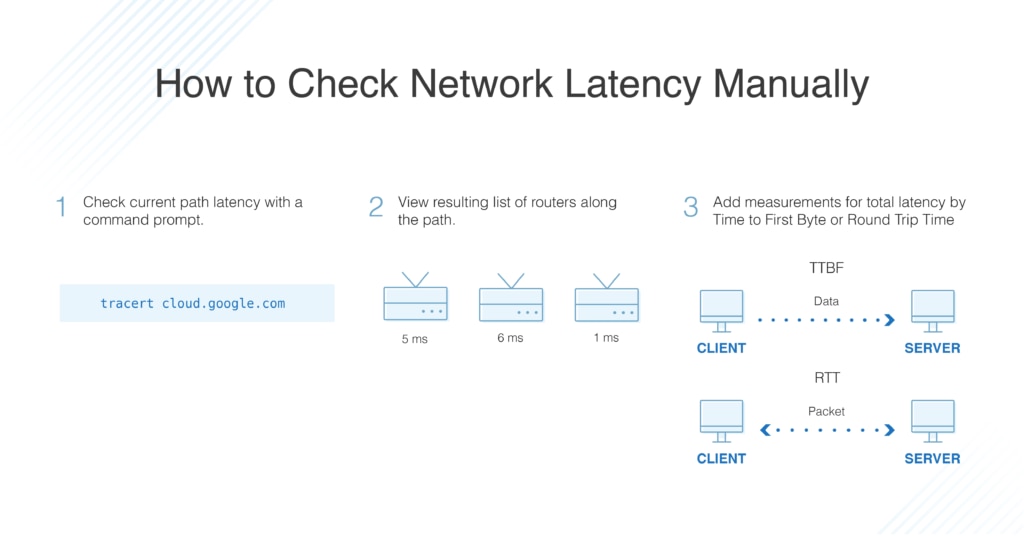One of the worst things to experience with your network is a sudden slowdown. Slow networks can be a disaster if you’re in the middle of an important business process, trying to impress a client, or rushing to complete an urgent task.
High latency can become increasingly problematic as networks grow bigger, as having more connections means more points where delays and issues can occur. These risks become greater as your business connects to cloud servers, uses more applications, or expands to include remote workers and branch offices.
If you’re wondering how to improve latency, I highly recommend understanding and setting up processes for checking and reducing this problem across your network, so when a problem arises, you’re already equipped to handle it.
What is Network Latency?

Network latency is the time it takes for data or a request to go from the source to the destination. Latency in networks is measured in milliseconds. The closer your latency is to zero, the better.
The most common signs of high latency include:
- Your data takes a long time to send, as in an email with a large attachment
- Accessing servers or web-based applications is slow
- Websites do not load
Determining your network latency and improving it so network processes run faster is important for business efficacy, as well as simply making your workday less frustrating.
Best Practices for Monitoring and Improving Network Latency
Before you can improve your network latency, it’s important to first understand how to determine your latency and the different ways you can measure it. By knowing your latency, you can better troubleshoot any problems you’re having to ensure data travels more quickly.

How to Check Network Latency
The first thing you need to do if you think your network is going slowly is to check your current network latency. Using Windows, you can open a command prompt and type tracert followed by the destination you’d like to query, such as cloud.google.com.
How to Measure Network Latency
Once you type in the tracert command, you’ll see a list of all routers on the path to that website address, followed by a time measurement in milliseconds (ms).
Add up all the measurements, and the resulting quantity is the latency between your machine and the website in question. IT administrators or professionals will typically use network monitoring and management tools to get this information automatically.
Latency can either be measured as the Round Trip Time (RTT) or the Time to First Byte (TTFB):
- RTT is defined as the amount of time it takes a packet to get from the client to the server and back.
- TTFB is the amount of time it takes for the server to receive the first byte of data when the client sends a request.
How to Reduce Network Latency
When you are considering how to improve network latency, there are different steps you can take at various points across the network. First, make sure other people on your network aren’t using up all the bandwidth or increasing your latency with lots of downloads or streaming. Then, check application performance to ensure no applications are acting in unexpected ways and putting pressure on the network.
Subnetting can also help reduce latency across your network as you can group together endpoints that communicate most frequently with each other. Additionally, consider using traffic shaping and bandwidth allocation measures to improve latency for the business-critical parts of your network. Finally, you can use a load balancer to help offload traffic to parts of the network with the capacity to handle some additional activity.
How to Troubleshoot Network Latency Issues
If you want to make sure latency issues are on your network, you can try disconnecting computers or network devices and restarting all the hardware. Make sure you also have a network device monitor installed so you can check if any of the devices on your network are specifically causing issues. Be aware, even if you fix a bottleneck somewhere in your network, you might simply be creating another one somewhere else.
If you still have latency problems after thoroughly looking at all your local devices, it’s possible the issues are coming from the destination you’re trying to connect to. Troubleshooting issues across a large network becomes complex when you try to pinpoint an issue manually, and I generally recommend troubleshooting tools and software to help you with this task.
How to Test Network Latency
Testing network latency can be done by using ping, traceroute, or My TraceRoute (MTR) tool. More comprehensive network performance managers can test and check latency alongside their other features.
The importance of measuring and reducing latency cannot be overstated, as maintaining a high-performance and reliable network is a big part of having a successful business. If managed poorly network issues can become a substantial business risk, so using appropriate management protocols and tools is vital for any professional enterprise.
What Tools Help Improve Network Latency?
Using tools to improve network latency is familiar to most network professionals, and there are several different options with network latency measuring features.
A network performance monitoring tool is the most comprehensive kind of tool you can use, as it normally includes features let you address latency and network performance. A tool like SolarWinds® Network Performance Monitor (NPM) also provides functions like network latency testing, network mapping, problem troubleshooting, and general network baselining.
With network monitoring tools, you can typically set network baseline expectations for latency and then set up alerts when the network latency reaches a certain threshold above this baseline. You can also often set up data comparisons between different metrics, so you can see links between different performance issues, such as application performance or errors also affecting network latency. A network mapping tool can also help you pinpoint where within the network latency the performance issues are occurring, which allows you to troubleshoot problems more quickly.
You can also look at using a dedicated traceroute tool to look at packets and how they move across an IP network, including how many “hops” the packet took, the roundtrip time, best time (in milliseconds), as well as the IP addresses and countries the packet traveled through. This can help you pinpoint the places in the network with high latency and troubleshoot those issues if they’re a part of your network under your control.
While many tools include traceroute capabilities in their suite of features, consider whether you need a full performance monitoring tool or if a traceroute tool is enough for your needs. If you’re looking for a basic option, you could use a free traceroute tool like Traceroute NG to find latency and packet loss occurring on a network. It can also detect path changes and send alerts. For a more robust latency monitoring solution, SolarWinds NPM is designed to identify the source and nature of network and application latency, reliability, and other performance problems.
All these tools can help you measure network latency across the entire network or between points. By improving your network speed and reducing latency, your business processes will also make leaps and bounds towards efficiency and high performance.


